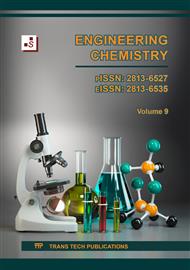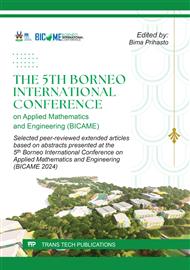[1]
Y. Song, G. Jiang, Y. Chen, P. Zhao, and Y. Tian, "Effects of chloride ions on corrosion of ductile iron and carbon steel in soil environments," Sci. Rep., vol. 7, no. 1, p.1–13, 2017.
DOI: 10.1038/s41598-017-07245-1
Google Scholar
[2]
R. Fan, W. Zhang, Y. Wang, D. Chen, and Y. Zhang, "Metal Material Resistant to Hydrochloric Acid Corrosion," J. Phys. Conf. Ser., vol. 1732, no. 1, 2021.
DOI: 10.1088/1742-6596/1732/1/012134
Google Scholar
[3]
Trethewey K.R & Chamberlain, Korosi untuk Mahasiswa dan Rekayasawan. Jakarta: PT. Gramedia Pustaka Utama, 1991.
Google Scholar
[4]
N. Azisah, D. Paroka, and W. Wahyuddin, "Analisa Penempatan Dan Kebutuhan Proteksi Katodik Pada Sistem Pipa Gas Bawah Laut Offshore Dari Pulau Pemping Ke Tanjung Uncang Batam," Zo. Laut J. Inov. Sains Dan Teknol. Kelaut., vol. 2, no. 3, p.57–63, 2020.
DOI: 10.20956/zl.v1i3.11978
Google Scholar
[5]
F. Krzyzanowski, M., Beynon, J. H. and R. B. J., D. C., Revie, R. W., Kreysa, G., Sch¨ utze, M., Roberge, P. R., Revie, R. W., Ghali, E., Sastri, V. S., Elboujdaini, M., Heimann, Oxide Scale Behavior in High Temperature Metal Processing Corrosion and Corrosion Control Corrosion Handbook - Corrosive Agents and Their Interaction with Materials Corrosion Inspection and Monitoring Corrosion Prevention and Protection Plasma Spray Coati. 2012.
DOI: 10.1002/maco.200790062
Google Scholar
[6]
S. Prifiharni et al., "Extract sarampa wood (Xylocarpus Moluccensis) as an eco-friendly corrosion inhibitor for mild steel in HCl 1M," J. Indian Chem. Soc., vol. 99, no. 7, p.100520, 2022.
DOI: 10.1016/j.jics.2022.100520
Google Scholar
[7]
et al Azis, "Pengaruh Konsentrasi Inhibitor Suplemen Vitamin C (Asam Askorbat) terhadap Laju Korosi Baja Api 5I Grade B pada Lingkungan 3,5% NaCl yang Mengandung Gas CO2," J. Tek. POMITS, vol. Vol. 2, No, 2013.
Google Scholar
[8]
N. Chaubey, Savita, A. Qurashi, D. S. Chauhan, and M. A. Quraishi, "Frontiers and advances in green and sustainable inhibitors for corrosion applications: A critical review," J. Mol. Liq., vol. 321, p.114385, 2021.
DOI: 10.1016/j.molliq.2020.114385
Google Scholar
[9]
R. Kusumastuti, R. I. Pramana, and J. W. Soedarsono, "The use of morinda citrifolia as a green corrosion inhibitor for low carbon steel in 3.5% NaCl solution," AIP Conf. Proc., vol. 1823, 2017.
DOI: 10.1063/1.4978085
Google Scholar
[10]
J. W. Soedarsono, M. N. Shihab, M. F. Azmi, and A. Maksum, "Study of curcuma xanthorrhiza extract as green inhibitor for API 5L X42 steel in 1M HCl solution," IOP Conf. Ser. Earth Environ. Sci., vol. 105, no. 1, 2018.
DOI: 10.1088/1755-1315/105/1/012060
Google Scholar
[11]
Y. L. Kobzar and K. Fatyeyeva, "Ionic liquids as green and sustainable steel corrosion inhibitors: Recent developments," Chem. Eng. J., vol. 425, no. April, p.131480, 2021.
DOI: 10.1016/j.cej.2021.131480
Google Scholar
[12]
M. R. Vinutha and T. V. Venkatesha, "Review on mechanistic action of inhibitors on steel corrosion in acidic media," Port. Electrochim. Acta, vol. 34, no. 3, p.157–184, 2016.
DOI: 10.4152/pea.201603157
Google Scholar
[13]
A. S. Amarasekara, "Acidic Ionic Liquids," Chem. Rev., vol. 116, no. 10, p.6133–6183, 2016.
DOI: 10.1021/acs.chemrev.5b00763
Google Scholar
[14]
W. E. S. Hart, J. B. Harper, and L. Aldous, "The effect of changing the components of an ionic liquid upon the solubility of lignin†," Green Chem., vol. 17, no. 1, p.214–218, 2015.
DOI: 10.1039/c4gc01888e
Google Scholar
[15]
C. Verma, I. B. Obot, I. Bahadur, E. S. M. Sherif, and E. E. Ebenso, "Choline based ionic liquids as sustainable corrosion inhibitors on mild steel surface in acidic medium: Gravimetric, electrochemical, surface morphology, DFT and Monte Carlo simulation studies," Appl. Surf. Sci., vol. 457, p.134–149, 2018.
DOI: 10.1016/j.apsusc.2018.06.035
Google Scholar
[16]
S.F.A,A.E. M, and E. A, "Eco-friendly chalcones derivatives as corrosion inhibitors for carbon steel in hydrochloric acid solution," African J. Pure Appl. Chem., vol. 7, no. 10, p.337–349, 2013.
DOI: 10.5897/ajpac2013.0520
Google Scholar
[17]
Fatkhurohmat, "Aplikasi Ekstrak Kulit Jeruk Nipis (Citrus Aurantifolia) Sebagai Inhibitor Organik Pada Baja Api 5L Grade B Media Larutan H2SO4 1M," (Doctoral Diss. Inst. Teknol. Sepuluh Nop., 2017.
Google Scholar
[18]
A. Zakeri, E. Bahmani, and A. S. R. Aghdam, "Plant extracts as sustainable and green corrosion inhibitors for protection of ferrous metals in corrosive media: A mini review," Corros. Commun., vol. 5, p.25–38, 2022.
DOI: 10.1016/j.corcom.2022.03.002
Google Scholar
[19]
T. Yunita, A. W. Putri Kusuma, S. E. Novita, and Sulistijono, "Effect of Addition Tahongai Leaf Extract (Kleinhovia hospita Linn.) As Organic Inhibitor on 1040 AISI Steel," IOP Conf. Ser. Mater. Sci. Eng., vol. 547, no. 1, 2019.
DOI: 10.1088/1757-899X/547/1/012006
Google Scholar
[20]
A. H. Al-Moubaraki, A. Al-Judaibi, and M. Asiri, "Corrosion of C-steel in the red sea: Effect of immersion time and inhibitor concentration," Int. J. Electrochem. Sci., vol. 10, no. 5, p.4252–4278, 2014.
DOI: 10.1016/s1452-3981(23)06620-8
Google Scholar
[21]
A. Dehghani, G. Bahlakeh, and B. Ramezanzadeh, "A detailed electrochemical/theoretical exploration of the aqueous Chinese gooseberry fruit shell extract as a green and cheap corrosion inhibitor for mild steel in acidic solution," J. Mol. Liq., vol. 282, p.366–384, 2019.
DOI: 10.1016/j.molliq.2019.03.011
Google Scholar
[22]
N. H. J. Al Hasan, H. J. Alaradi, Z. A. K. Al Mansor, and A. H. J. Al Shadood, "The dual effect of stem extract of Brahmi (Bacopamonnieri) and Henna as a green corrosion inhibitor for low carbon steel in 0.5 M NaOH solution," Case Stud. Constr. Mater., vol. 11, p. e00300, 2019.
DOI: 10.1016/j.cscm.2019.e00300
Google Scholar
[23]
A. Singh et al., "Plant derived cationic dye as an effective corrosion inhibitor for 7075 aluminum alloy in 3.5% NaCl solution," J. Ind. Eng. Chem., vol. 20, no. 6, p.4276–4285, 2014.
DOI: 10.1016/j.jiec.2014.01.033
Google Scholar
[24]
Y. Triana, P. R. Utami, A. D. Laksono, J. Awali, G. U. N. Tajalla, and Sulistijono, "The Effect of Addition Organic Inhibitor Bintaro Fruit Extract (Cerbera Manghas) to Inhibition Eficiency and Corrosion Rate on JIS G3131 Steel in 0,1 M H2so4 Environment," J. Phys. Conf. Ser., vol. 1803, no. 1, 2021.
DOI: 10.1088/1742-6596/1803/1/012013
Google Scholar
[25]
A. Dehghani, G. Bahlakeh, B. Ramezanzadeh, and M. Ramezanzadeh, "Potential of Borage flower aqueous extract as an environmentally sustainable corrosion inhibitor for acid corrosion of mild steel: Electrochemical and theoretical studies," J. Mol. Liq., vol. 277, p.895–911, 2019.
DOI: 10.1016/j.molliq.2019.01.008
Google Scholar
[26]
R. Setyawaty, J. Farmasi, F. Farmasi, A. Farmasi Kusuma Husada, J. Karangbenda Raya - Berkoh, and R. B. Aptuning, "Pharmaceutical Journal Of Indonesia Preliminary Studies on the Content of Phytochemical Compounds On Skin of Salak Fruit (Salaccazalacca)," Pharm. J. Indones., vol. 6, no. 1, p.1–6, 2020.
DOI: 10.21776/ub.pji.2020.006.01.1
Google Scholar
[27]
I. G. A. S. Dhyanaputri, I. W. Karta, and L. A. W. Krisna, "Analisis Kandungan Gizi Ekstrak Kulit Salak Produksi Kelompok Tani Abian Salak Desa Sibetan Sebagai Upaya Pengembangan Potensi Produk Pangan Lokal I Gusti Ayu Sri Dhyanaputri 1 , I Wayan Karta 2 , Luh Ade Wilan Krisna 3," Meditory, vol. 4, no. 2, p.93–100, 2016.
DOI: 10.33992/m.v4i2.48
Google Scholar
[28]
F. & Andriani, "Screening of antioxidant activities and their bioavailabilityof tropical fruit By products from Indonesia," Int. J. Pharm. Pharm. Sci., p.95–100, 2016.
Google Scholar
[29]
I. W. Karta, L. A. N K Eva Susila, I. N. Mastra, and P. G. A. Dikta, "Kandungan Gizi Pada Kopi Biji Salak (Salacca zalacca) Produksi Kelompok Tani Abian Salak Desa Sibetan yang Berpotensi Sebagai Produk Pangan Lokal Berantioksidan dan Berdaya saing," J. Virgin, Jilid, vol. 1, no. 2, p.123–133, 2015.
DOI: 10.33319/agtek.v24i2.151
Google Scholar
[30]
E. Erwansyah and C. Pratiwi, "The effect of snakefruit extract (Salacca zalacca) in inhibiting the release of chromium (Cr) and nickel (Ni) ion from stainless steel orthodontic wire to saliva," Int. J. Appl. Pharm., vol. 11, no. 4, p.33–36, 2019.
Google Scholar
[31]
Khan, M. A., & Ahmad, S. Evaluation of Plant Extracts as Green Corrosion Inhibitors for Carbon Steel in Acidic Media. Corrosion Science, 170, 107522, 2020
Google Scholar
[32]
Singh, R., & Kumar, V. Green Corrosion Inhibition of Mild Steel in 1M HCl Using Neem (Azadirachta indica) Leaf Extract. Journal of Molecular Liquids, 289, 110874, 2019
Google Scholar
[33]
Zhang, Y., Li, X., & Wang, S. Investigation of Plant-Derived Corrosion Inhibitors for Steel in Acidic Environments. International Journal of Electrochemical Science, 16(3), 2543-2558, 2021
Google Scholar
[34]
C. Verma, I. B. Obot, E. E. Ebenso, M. A. Quraishi, and I. Bahadur, "Choline-based ionic liquids as sustainable corrosion inhibitors on mild steel surface in acidic medium: Gravimetric, electrochemical, surface morphology, DFT, and Monte Carlo simulation studies," Appl. Surf. Sci., vol. 457, p.134–149, 2018.
DOI: 10.1016/j.apsusc.2018.06.035
Google Scholar
[35]
S. A. Umoren, M. M. Solomon, "Synergistic corrosion inhibition effect of metal cations and mixtures of organic compounds: A review," J. Environ. Chem. Eng., vol. 5, no. 3, p.246–257, 2017.
DOI: 10.1016/j.jece.2017.02.024
Google Scholar
[36]
S. Werdyani, P. Jumaryatno, and N. Khasanah, "Antioxidant Activity of Ethanolic Extract and Fraction of Salak Fruit Seeds (Salacca Zalacca (Gaertn.) Voss. ) Using Dpph (2,2-Diphenyl-1- Picrylhydrazyl) Method," J. Eksakta, vol. 17, no. 2, p.137–146, 2017.
DOI: 10.20885/eksakta.vol17.iss2.art5
Google Scholar
[37]
F. Z. Nisa, M. Astuti, S. M. Haryana, and A. Murdiati, "Antioxidant Activity and Total Flavonoid of Carica papaya L. Leaves with Different Varieties, Maturity and Solvent," agriTECH, vol. 39, no. 1, p.54, 2019.
DOI: 10.22146/agritech.12813
Google Scholar
[38]
S. Ariviani and N. H. R. Parnanto, "Kapasitas Antioksidan Buah Salak (Salacca Edulis Reinw) Kultivar Pondoh, Nglumut Dan Bali Serta Korelasinya Dengan Kadar Fenolik Total Dan Vitamin C," Agritech, vol. 33, no. 3, p.324–333, 2013, [Online]. Available: https://journal.ugm.ac.id/agritech/article/view/9555/7130
DOI: 10.22146/agritech.55376
Google Scholar
[39]
N. O. Eddy, S. A. Odoemelam, E. C. Ogoko, R. A. Ukpe, R. Garg, and B. Anand, "Experimental and quantum chemical studies of synergistic enhancement of the corrosion inhibition efficiency of ethanol extract of Carica papaya peel for aluminum in solution of HCl," Results Chem., vol. 4, no. August 2021, p.100290, 2022.
DOI: 10.1016/j.rechem.2022.100290
Google Scholar
[40]
N. Subekti, J. W. Soedarsono, R. Riastuti, and F. D. Sianipar, "Development of environmental friendly corrosion inhibitor from the extract of areca flower for mild steel in acidic media," Eastern- European J. Enterp. Technol., vol. 2, no. 6–104, p.34–45, 2020, doi: 10.15587/1729- 4061.2020.197875.
DOI: 10.15587/1729-4061.2020.197875
Google Scholar
[41]
Y. M. Li et al., "Iron-tannic acid nanocomplexes: Facile synthesis and application for removal of methylene blue from aqueous solution," Dig. J. Nanomater. Biostructures, vol. 11, no. 4, p.1045– 1061, 2016.
Google Scholar
[42]
W. Xu, E. H. Han, and Z. Wang, "Effect of tannic acid on corrosion behavior of carbon steel in NaCl solution," J. Mater. Sci. Technol., vol. 35, no. 1, p.64–75, 2019.
DOI: 10.1016/j.jmst.2018.09.001
Google Scholar
[43]
L. Chen, D. Lu, and Y. Zhang, "Organic Compounds as Corrosion Inhibitors for Carbon Steel in HCl Solution: A Comprehensive Review," Materials (Basel)., vol. 15, no. 6, p.1–59, 2022.
DOI: 10.3390/ma15062023
Google Scholar



